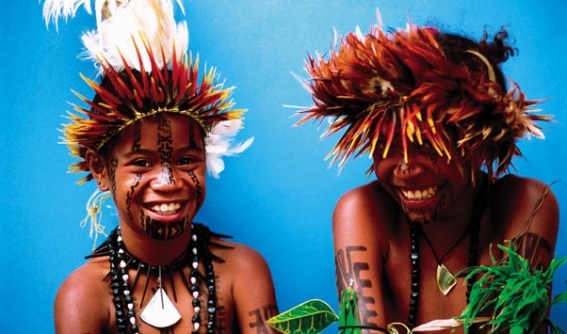Papua New Guinea: Niche targets for Papua New Guinea’s tourism industry
2015/12/28

A rise in historical battlefield tourism across a variety of international destinations has shone a spotlight on a key niche market with potential for Papua New Guinea, as the country begins preparations for a series of events commemorating the 75th anniversary of strategic battles fought during the Second World War.
The country’s unspoilt wildernesses and close proximity to key regional markets are also likely give the tourism industry an added boost in the coming years, though its total contribution to the national economy will remain relatively modest, at around 2% of GDP.
PNG’s tourism industry is expected to expand by 6.7% this year, with annual growth averaging 5.3% through to 2025, according to the World Travel & Tourism Council, placing it in the top 10% of the 184 countries surveyed in terms of forecast growth.
Some 172,000 international visitors are expected to visit by year’s end, climbing to 238,000 per annum by 2025, the council noted.
The Kokoda effect
The governments of PNG and Australia are planning a series of commemorative events in 2017 and 2018 to mark the 75th anniversary of the battles that took place in PNG between the Allies and the Japanese during the Second World War.
The planned activities will focus on and around an area known as the Kokoda Track, a winding trail in the centre of the country that marks the spot where Allied troops, mainly Australians and Papuans, halted the Japanese offensive on Port Moresby and drove back invading forces in a series of battles in 1942-43.
The events are expected to yield benefits for the country’s tourism industry, with increased visitor numbers, as well as contingents of official guests, likely to be attracted, as has been the case for previous memorial celebrations.
More formal recognition of the sites could also boost their tourism appeal. In mid-August the governments of PNG and Australia announced plans to jointly seek UNESCO World Heritage status for the Kokoda Track and other sites in the Owen Stanley Range in a bid to preserve the natural and historic fabric of the region, and ensure it retains its appeal to visitors.
Trekker’s paradise
According to British historian and battlefield tour leader Peter Hart, the recent spate of high-profile anniversaries marking the centenary of the First World War in locations on the Western Front and at the sites of the Gallipoli Campaign in Turkey generated a surge in niche tourism. Host countries, he told OBG, witnessed a sharp rise in visitor numbers, with the benefits for the tourism industry producing a significant impact on the local economies.
“A similar spike of interest can be expected to attend the commemorative events planned to mark the battles along the Kokoda Trail and across PNG,” he told OBG, with greater interest likely to be generated by commemorative books and television programming.
Hart said the trail was already gaining popularity with Australian visitors, with the trek across rough terrain regarded as a challenge for adventure travellers. Estimates suggest that up to 5000 foreign visitors — mainly Australians — currently walk the 96-km route each year.
The expected increase in trekkers in the coming years could provide opportunities for investment in lodgings and services along the track. According to the PNG government, “trekker accommodation”, a new category of tourist lodging, is being piloted in the 2016 trekking season to cater to this growing segment.
Niche appeal
Kayleen Allen, a project manager with the PNG Tourism Promotion Authority, told participants at a seminar in late September that PNG should place a greater emphasis on attracting adventure travellers.
“PNG as a tourism destination… is for someone that’s coming here for a specific type of niche, whether it’s diving or trekking to experience the cultural life, and that’s what we need to be able to package and deliver,” Allen said.
The country’s relative proximity to Australia and New Zealand could be another key driver of future growth, according to Richard Knight, the owner of the Loloata Island Resort, particularly for niche travellers.
“PNG may never turn into a mass market, but it can be a niche market of great appeal to more affluent Asian countries like Japan, Korea and Singapore,” he told OBG earlier this year, “not to mention China, where 98m people took holidays abroad in 2013 alone.”
Regional benchmarking
Officials have suggested that PNG could better harness the economic potential of its tourism industry. Despite being the largest nation in the Pacific region, PNG accounts for just 10% of regional tourism, according to Loi Bakani, governor of the Bank of PNG, compared to 41% for Fiji. “It creates jobs, foreign exchange, encourages entrepreneurships and has significant spill-over effect in commerce and transport,” he said, speaking at a tourism convention in late October.
Signalling the government’s commitment to boosting tourism revenues, the 2016 budget, released in early November, included a PGK50m ($17m) increase in investment in the sector – one of the largest increases in a decade and up more than three-fold over the PGK11.6m ($3.9m) allocated last year.
The government hopes such a capital injection will give the industry an added boost and offer another avenue for economic diversification. “We cannot depend on our gas and gold forever,” Prime Minister Peter O’Neill said in early November. “We want to sell some of the other wonderful aspects of the country – the environment, the culture.”
- Related Articles
-
El Niño takes its toll on Papua New Guinea’s agricultural output
2016/02/14 Efforts to promote agricultural self-sufficiency in Papua New Guinea saw a setback in 2015, with droughts and supply chain disruptions impeding sector increase. To allow for lower prices and better market competition, Tommy Tomscoll, minister for agriculture and livestock, announced plans in mid-January to lift restrictions on a range of agricultural imports, inclunding fresh produce and poultry, for three months, sparking resistance from a lot of businesses and retail operators. -
Papua New Guinea pursues value-added tuna processing
2015/12/28 A regulatory overhaul is paving the way for Papua New Guinea to focus on developing the processing side of its fisheries industry, supporting the country’s plans to become a major downstream player in the world tuna market. The new policy, which includes a requirement that 100% of tuna caught in PNG’s archipelagic waters be processed locally, is expected to boost the sector’s contribution to GDP through better price-added production, higher exports and job creation. The regulations could as well bring about tighter control of the country’s territorial waters, helping authorities address concerns about unregulated fishing practices and preserve business-free access to the EU market. -
Increase among the 21 Asia-Pacific Economic Cooperation (APEC)
2015/11/18 Increase among the 21 Asia-Pacific Economic Cooperation (APEC) economies softened to 3.1 % in the second quarter of 2015, down from 3.2 % in the initial quarter and 3.4 % a year ago, according to an APEC economic analysis released on Tuesday. The statement said the increase slowdown reflected the prolonged weakness in world economic activity as the modest recovery in advanced economies was matched by a general slowdown in emerging market economies. The moderation in GDP levels could be attributed to declining investments and lacklustre exports, according to the statement. "Economies across the Asia-Pacific continue to grow but find themselves in a holding pattern of lower increase in the absence of high trade volumes," said Alan Bollard, Executive Director of the APEC Secretariat. -
Revised IMF forecasts signal gloom on global economic outlook
2015/01/20 Low oil prices will not provide a sufficient updraught to dispel the clouds hanging over the world economy, the International Monetary Fund said on Tuesday. In a sign of its increasing gloom about the medium term economic outlook, the IMF cut its world economic increase forecasts by 0.3 % points for both 2015 and 2016, despite believing cheaper oil represents a “shot in the arm”. -
Oxfam Study Finds Richest 1% Is Likely to Control Half of Global Wealth by 2016
2015/01/20 The richest 1 % are likely to control additional than half of the globe’s total wealth by next year, the charity Oxfam reported in a study released on Monday. The warning about deepening world inequality comes just as the world’s business elite prepare to meet this week at the annual World Economic Forum in Davos, Switzerland. The 80 wealthiest people in the world all own $1.9 trillion, the statement found, nearly the same all shared by the 3.5 billion people who occupy the bottom half of the world’s gain scale. (Last year, it took 85 billionaires to equal that figure.) And the richest 1 % of the people, who number in the millions, control nearly half of the world’s total wealth, a share that is as well increasing.
-
- Papua New Guinea News
-
- PAPUA NEW GUINEA: El Niño takes its toll on Papua New Guinea’s agricultural output
- PAPUA NEW GUINEA: Papua New Guinea pursues value-added tuna processing
- PAPUA NEW GUINEA: Niche targets for Papua New Guinea’s tourism industry
- BRUNEI : APEC economies growth slows to 3.1 pct in Q2
- AFGHANISTAN: Revised IMF forecasts signal gloom on global economic outlook
- AFGHANISTAN: Oxfam Study Finds Richest 1% Is Likely to Control Half of Global Wealth by 2016
- Trending Articles
-
- SOUTH AFRICA: South Africa to extend ICT reach
- AZERBAIJAN: Azerbaijan to become export gateway for Indonesian products to European market
- INDIA: Indian central bank chief to step down in surprise move
- ABIDJAN: Cote d’Ivoire to re-emerge as a tourism destination
- AFRICA: More than 41 million in southern Africa face food insecurity
- CHINA: Chinese Developers Delay Bond Maturity, Deficit to Peak in 2020








